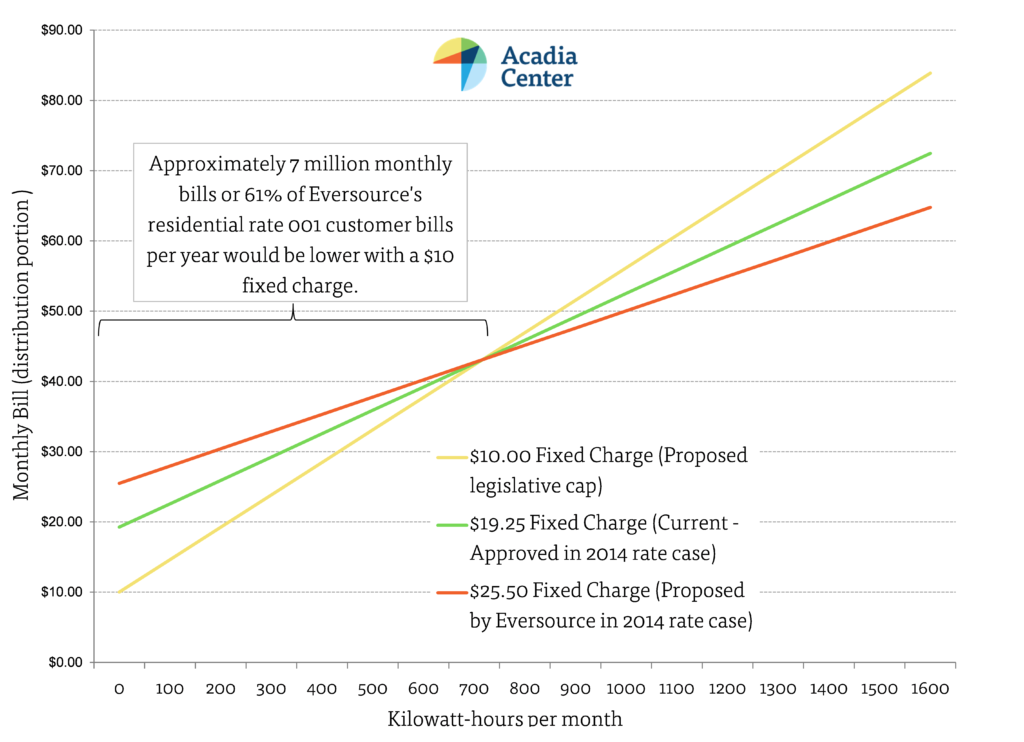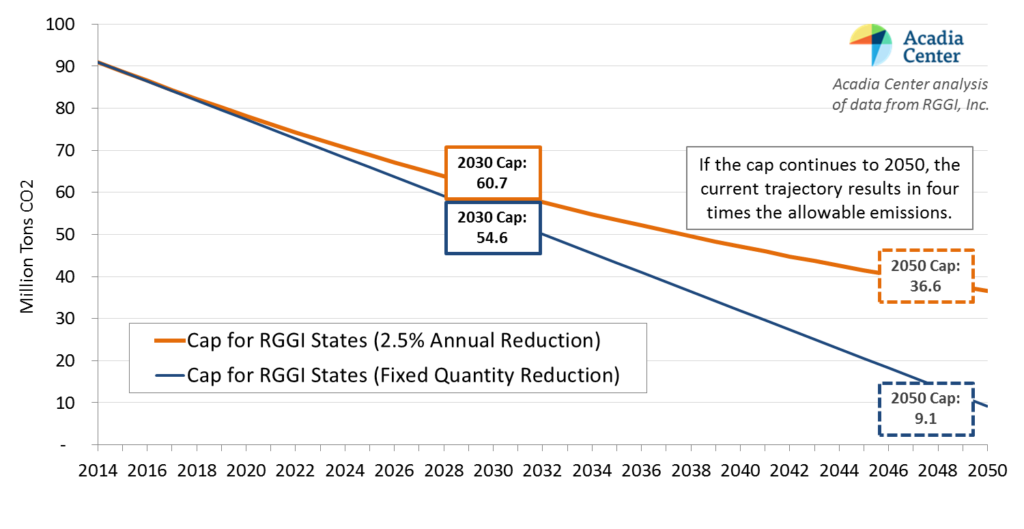Energy Efficiency Winning Out in Rhode Island
The Rhode Island General Assembly has demonstrated its long-standing commitment to reducing the state’s energy costs through smart and economic investments in low-cost energy efficiency. This spring, the legislature approved a 5- year extension of Least Cost Procurement (LCP), the state’s policy of investing in as much low-cost energy efficiency as possible, and created the Rhode Island Infrastructure Bank, a new clean energy financing tool.
Least Cost Procurement, first implemented 8 years ago, is largely responsible for Rhode Island’s tie with Massachusetts for #1 state in the country for utility-sector energy efficiency programs and policies in the American Council for an Energy Efficiency Economy (ACEEE)’s 2014 State Scorecard. Investing in low-cost energy efficiency instead of expensive electricity and natural gas helps Rhode Islanders lower their energy bills and spurs economic growth. Lower utility bills means that Rhode Islanders have more money left at the end of the month to spend on other things, and most of that spending happens locally. Since 2008, Rhode Island has invested $558 million in energy efficiency and consumers have realized $1.99 billion in economic benefits.
The state’s investments in energy efficiency from last year alone are expected to generate 3,607 job years of employment, increase personal income by $244 million, and increase state tax revenue by $15 million over the next thirteen years.
The Rhode Island Infrastructure Bank (RIIB) will work to increase those benefits by utilizing loan-based financing to enhance the state’s energy efficiency programs and make energy efficiency projects more accessible for RI municipalities, residents, and businesses. The Efficient Buildings Fund at RIIB will provide energy efficiency financing to municipalities for upgrades to public buildings and facilities. RIIB will also administer Property Assessed Clean Energy (PACE) financing for residential and commercial property-owners. PACE allows property owners to borrow money for clean energy upgrades and repay the loan on their property tax bill.
As the RIIB was developed, Acadia Center provided input to policymakers and key stakeholders and shared lessons learned from other states’ experience with clean energy financing. Going forward we will work with stakeholders as they implement RIIB and provide that same support. Acadia Center will continue to represent environmental interests on the Energy Efficiency and Resource Management Council to ensure that Rhode Island consumers benefit from the low cost, low risk energy efficiency resource.
Download Rhode Island’s Legislative Wrap-Up here.
Abigail Anthony leads Acadia Center’s Grid Modernization and Utility Reform initiative, focusing on changing regulatory and economic incentives in order to achieve a sustainable and consumer-friendly energy system. A Rhode Island native, Abigail is director of the Providence office and has played a leading role in advancing the state’s energy efficiency procurement policies.
What is the Value of Solar Power in Rhode Island? A New Study
A new study released this week by Acadia Center quantifies the grid and societal benefits of solar photovoltaic systems (solar PV) in Rhode Island. Establishing the value of distributed resources like rooftop solar is increasingly important as states explore ways to meet energy needs and deploy clean energy resources.
Acadia Center assessed the grid and societal value of six solar PV systems to better understand the overall value that solar PV provides in Rhode Island. The analysis determined that the value of solar to the grid – and ratepayers connected to the grid – ranges from 19-25 cents/kWh. These values derive from solar PV’s ability to reduce energy demand and provide power during peak periods, thus avoiding generation and related emissions from conventional power plants. The overall grid value of solar is the sum total of these different benefits.
The study also finds that solar PV provides broader societal advantages (such as environmental benefits from avoided greenhouse gas emissions) valued at approximately 7 cents/kWh. This additional value should be considered when assessing costs and benefits and determining additional incentives for solar producers.
One of the key findings is that west-facing solar PV systems in particular are not being adequately compensated under existing programs – like net-metering- which provide a single level of compensation and encourage south-facing installations that maximize kWh output. These programs do not fully account for the value that west-facing systems provide in mitigating costs driven by afternoon peak demand (see Table 1 in the report). Incentives should be designed to maximize the value that solar PV provides to system owners and ratepayer rather than simply encouraging system owners to maximize kWh output. This will help ensure that incentives are fair and optimize grid support.
In fact, the value of west-facing systems is already coming into play in Rhode Island where the Office of Energy Resources has procured 250 kW of peak load reduction – with additional incentives for west-facing solar systems – in the Tiverton and Little Compton area. This is being done in conjunction with National Grid’s “DemandLink” pilot, which is using targeted efficiency and demand response to avoid a new substation feeder in the area; ultimately deferring approximately $2.9 million in new distribution-related costs.
While not included in Acadia Center’s analysis, locational values are important to maximize the savings in distribution costs that solar can bring to ratepayers. Appropriate incentives can ensure that solar PV, energy efficiency, and other customer-side resources are targeted to defer or avoid the need for new infrastructure spending.
This study comes at a particularly interesting time as new solar programs and businesses are being introduced in the state. The Renewable Energy Growth Program, launched this June, gives Rhode Islanders the chance to offset their electricity bills and sell their excess electricity from distributed resources to National Grid through a long-term tariff at a guaranteed fixed price. Programs like these are expected to facilitate a bigger shift toward solar and other distributed generation in the state. As a first step in response to this new trend, the RI Public Utility Commission has opened a docket to assess distribution rate design and cost allocation. Having a better understanding of the value that solar provides to the grid and ratepayers will help inform this proceeding, which could be precedent setting for other jurisdictions.

Leslie Malone is a Senior Analyst at Acadia Center based in the Providence office. Leslie is involved in research and analysis of energy efficiency and clean energy, specifically solar.
Envisioning the Energy Future for Rhode Island: Event Recap
On June 26, Acadia Center hosted UtilityVision: A Discussion about the Clean Energy Future for Rhode Island at The Rhode Island Foundation in Providence. The objective was to provide an in-depth look at what the clean energy future could be for Rhode Island and beyond, as well as engage diverse stakeholders to work through the various challenges to implementation. Acadia Center’s presentation described a practical and positive pathway to achieving Rhode Island’s climate change goals and recommendations for reforming the way the energy system is paid for and planned.

The meeting brought together a diverse group of Rhode Islanders who are thinking about the future of the state’s energy system. Attendees included representatives from clean energy companies, universities, state and federal policy makers, consumer and environmental advocates, state environmental agencies, and the media.
Following the presentations, attendees enthusiastically participated in discussion groups led by Acadia Center staff. The discussion groups each focused on: investments in big infrastructure like pipelines and their impact on Rhode Island’s clean energy future; the changes necessary to fully benefit from new clean energy technology; the reforms needed to align utility incentives with consumer and environmental goals; and the challenges energy efficiency programs face.
These topics sparked lively dialogue and some insights including:
- Rhode Island has nation-leading energy efficiency programs, but there are still hard-to-reach sectors like renters that struggle to benefit from them. If municipalities require landlords to share past energy bills with prospective tenants or create a minimum energy standard for all rental housing, it could ensure that all renters are protected from burdensome energy bills.
- Rhode Islanders need to make sure the right questions are being asked about proposals to publicly finance expanded natural gas pipelines that could lock the state into an outdated energy system for the next half-century. Decision-makers should ask more questions about potential lower risk, lower cost, and cleaner solutions.
- New electric technologies, like electric vehicles (EVs) and battery storage, have the potential to help Rhode Island meet its climate change goals. However, there are barriers to consumer adoption of EVs in the region, including reluctance by auto dealers to market them due to the need for more time spent educating the consumer and lower future revenue potential from vehicle maintenance. Utilities may need different financial incentives in order to be full partners in promoting electric vehicles and help overcome these barriers.
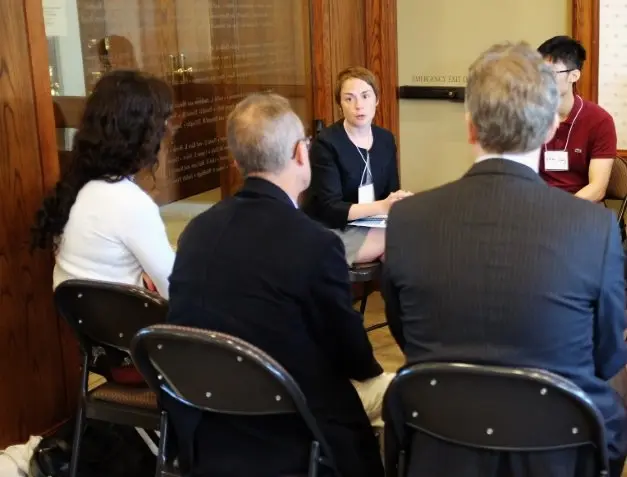
In the coming months Acadia Center will address many of these concerns by participating in the development of the state’s 2016 Energy Efficiency and System Reliability Program Plan, and in the RI Public Utilities Commission’s proceeding on reforming electric distribution rates in light of a changing energy system. We hope to stay connected with those who joined the event to provide updates and coordinated support for progress toward a clean energy future.
Abigail Anthony leads Acadia Center’s Grid Modernization and Utility Reform initiative, focusing on changing regulatory and economic incentives in order to achieve a sustainable and consumer-friendly energy system. A Rhode Island native, Abigail is director of the Providence office and has played a leading role in advancing the state’s energy efficiency procurement policies.
Protect Consumers and Savings –Don’t Raise Fixed Charges
At legislatures and regulatory bodies across the country a debate rages on over consumers’ control of their electricity bills. The debate centers on fixed charges, a monthly fee to obtain access to electricity that applies regardless of how much electricity a consumer actually uses.
Utilities are in favor of increasing fixed charges because it would increase certainty: the utility knows that it will collect a certain amount of revenue from all of its customers each month, regardless of the amount of electricity consumed. Consumers and their advocacy allies, on the other hand, are pushing to prevent these increases because they would reduce consumer control over energy bills, undermine the clean energy future, and reduce economic incentives for consumers to invest in energy efficiency and distributed generation.
Acadia Center recently analyzed the impact of increasing fixed charges in Rhode Island in a revenue-neutral scenario. In this scenario the utility is not allowed to increase the total amount of revenue it collects, just redistribute the total between fixed charges and the variable charges based on consumer’s energy use. National Grid will be proposing revenue-neutral changes to the fixed and variable charges in July, as required by Rhode Island Renewable Energy Growth program law. The analysis determined that if the fixed portion of the bill is increased, then the per-kilowatt-hour charge will be lowered because less revenue will need to be collected in that way (see table below). This essentially means that any effort consumers make to lower their energy usage and become more efficient will be less valuable because the majority of their bill is fixed.
Percent Change in Variable Rates Compared to the Current $5 Fixed Customer Charge and Revenue Requirement for Residential Customers in Rhode Island
| $10 Fixed Charge | -22% | $10 Minimum Bill | -6% |
| $15 Fixed Charge | -44% | $15 Minimum Bill | -17% |
| $20 Fixed Charge | -67% | $20 Minimum Bill | -36% |
| $25 Fixed Charge | -89% | $25 Minimum Bill |
-60% |
The analysis also showed that a significant number of Rhode Island customers—those using less electricity than the monthly average — would see an increase in their electricity bill if fixed charges were increased above the current $5/month; higher usage customers’ bills would go down due to the lower variable rate. These results show that high fixed charges are regressive: low-use customers see their bills increase, while higher-use customers see their bills decrease.
Impact of Higher Fixed Charges by Monthly Usage Level Compared to the Current $5 Customer Charge and Revenue Requirement for Residential Customers in Rhode Island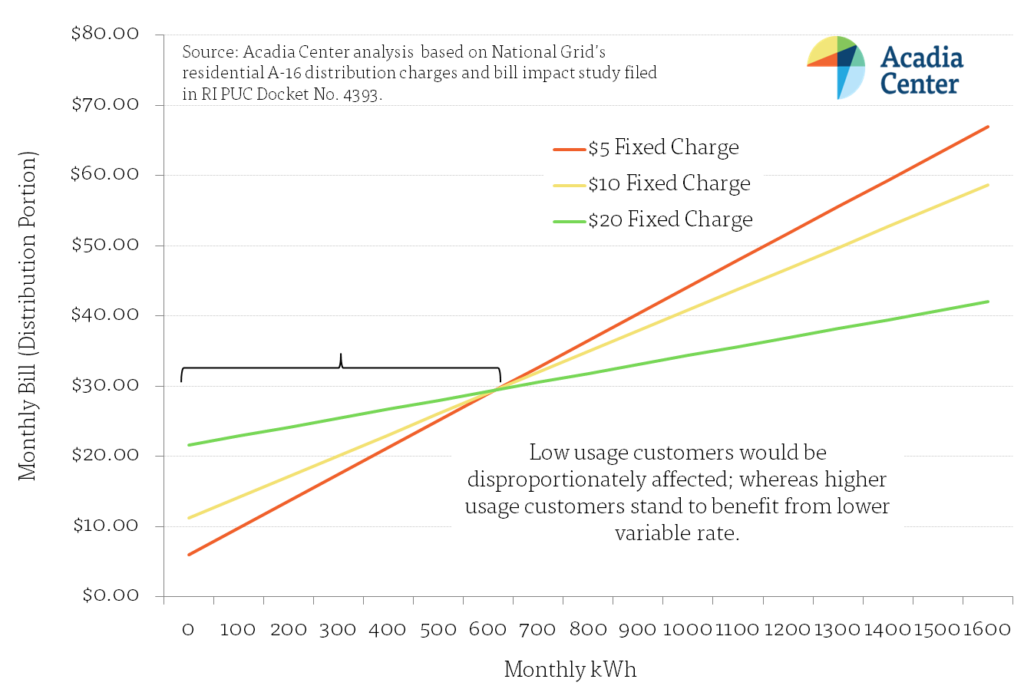
Acadia Center recommends that policymakers and regulators avoid reliance on fixed charges. Instead, policymakers should consider the following recommendations for short-term reforms that protect consumers and maintain incentives to use energy wisely:
- Adopt a narrow definition of fixed charges. Limit fixed charges to the cost of keeping a customer connected to the grid, such as metering, billing, and the service drop. The impact of public policy considerations should be factored in as well.
- Increase transparency. The components of a cost of service study that are included in the fixed customer charge, and the data, process, and methodology used to determine the components, should be publicly available and easily accessible.
Envisioning the Energy Future for RI: Making the System Work for Consumers and the Environment
As consumers become more aware of the costs and impacts of energy use on health and the environment, we’re looking for ways to re-envision the energy system. With emerging technologies and approaches, a new system is possible.
Acadia Center invites you to a discussion, hosted by the Rhode Island Foundation, which will lay out a strategic plan to achieve a new system that meets our energy needs and supports a fair, healthy economy and environment.
Acadia Center staff will tell the story of how we can get there. The presentation will draw on the user-friendly visuals, recommendations and original research in our recent reports EnergyVision and UtilityVision, with background on trends from ClimateVision 2020. It will show an optimistic and achievable pathway for making deep greenhouse gas reductions and introduce specific recommendations for advancing a consumer- and environmentally-friendly clean energy future. The presentation portion will be engaging and brief, leaving plenty of time for questions and discussion. We hope you will join us.
When
Friday, June 26 10 AM – 12 PM
Where
Rhode Island Foundation
1 Union Station
Providence, RI 02903
We encourage you to use public transportation, but the Rhode Island Foundation is generously offering to validate parking.
RSVP
If you plan to come, please register on our Eventbrite page. The event is free and all are welcome to register.
Support a Clean Energy Future: Event Recap
Acadia Center is grateful to our friends and colleagues who made it out to Boston’s District Hall on a rainy Monday night to share in conversation about realistic pathways to a brighter, clean energy future.

Acadia Center provided updates on efforts to re-energize state leadership to address climate change, reduce emissions and advance clean energy. Staff experts were on-hand to answer questions and engage in discussion on key issues such as extending MA’s leadership on energy efficiency; increasing incentives and infrastructure for electric vehicles; harnessing solar power and other clean energy resources; and, leveraging RGGI and carbon markets.
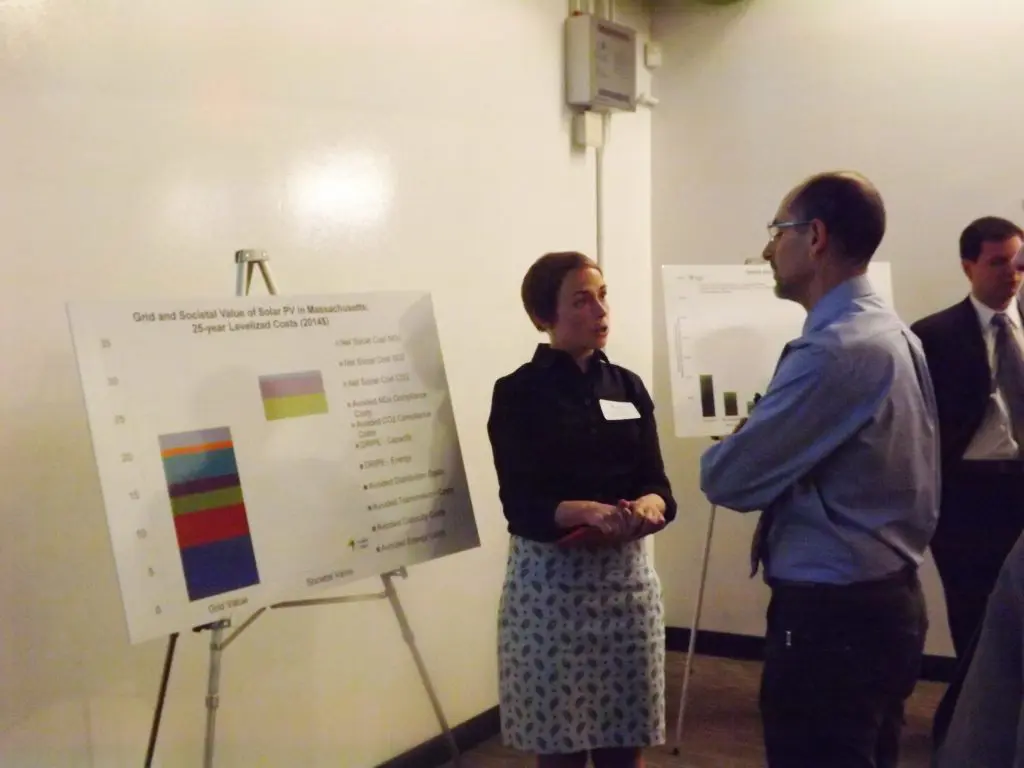 Leslie Malone, Senior Analyst, shares results of Acadia Center’s Value of Solar study for Massachusetts
Leslie Malone, Senior Analyst, shares results of Acadia Center’s Value of Solar study for Massachusetts
Posters with infographics and charts helped jumpstart conversation and showcased a key element of Acadia Center’s approach: credible research with user-friendly visual presentation that tells a story. Some recent publications include EnergyVision and UtilityVision, which illustrate pathways to deep carbon reductions and a consumer-friendly energy system.
 Acadia Center President Daniel Sosland displays UtilityVision, a framework for advancing a modern clean energy grid that literally paints a picture of what our clean energy future could look like
Acadia Center President Daniel Sosland displays UtilityVision, a framework for advancing a modern clean energy grid that literally paints a picture of what our clean energy future could look like
Please join Acadia Center for our next event: Envisioning the Energy Future for RI: Making the System Work for Consumers and the Environment. Friday, June 26, 10am -12pm, in Providence, RI at the offices of the Rhode Island Foundation. Learn more and register here.
Relationship Counseling with Your Utility is Better than Breaking Up
Frustration with utilities combined with declining costs of solar and energy storage has raised the possibility that customers will start divorcing from the grid. Cutting the cord and going “off-grid” has technically been possible for decades, but as costs fall, the idea is starting to gain some real traction. SolarCity, a solar power provider, plans to lease solar photovoltaic (PV) plus storage systems in Hawaii, where high power prices, abundant sunshine and frustration with the local utility has made grid divorce alluring.
While the thought of ending your relationship with a utility may be satisfying, it would undermine our capacity to reduce emissions and set back efforts to modernize the grid.
Battery storage clearly has an emerging and important role in our energy future, but using it to fully sever ties with utilities leaves many of the benefits of both storage and clean generation unrealized. Sure you may feel that you’re trapped in a one-sided relationship, that your concerns and needs are not being addressed, or that the utility does not reflect your values. But rather than cutting the cord, the solution is making structural changes to the grid that will move us toward a clean energy economy that benefits consumers.
Acadia Center examined the impact of adding battery storage (equivalent to Tesla’s Powerwall, a new battery system) and solar PV to homes in Connecticut, Hawaii, and Arizona to see what it would take to become independent from the grid. In all three states, going off-grid with a “right-sized” net-zero PV array (where a home’s demand for power approximately equals the energy it produces over a year) would be expensive. In New England, a very large number of batteries– 62 in Connecticut – would be needed to allow for year-round uninterrupted power off the grid. This is due to significantly lower winter PV production in the region and the resulting need for more batteries to store enough power to get a home through a long winter.
In sunnier and warmer climates with higher solar production in the winter, like Hawaii and Arizona, you would only need 40 and 42 batteries, respectively, to take a net zero home off-grid. But, average annual electric demand is higher in those states, so battery needs and cost would still be high when coupled with smaller solar PV arrays.
The least expensive path to an off-grid system is to oversize the solar PV array in order to reduce the number of batteries needed. (See chart and figure below.) Yet, while less costly, oversized solar arrays that are not connected to the grid essentially “waste” clean energy. In other words, once your demand is satisfied and the batteries are full, any excess energy that would otherwise be fed into the grid just dissipates. The Connecticut home with a 12.5 kW array may have reduced system costs, but it is now producing approximately 8,900 kWh per year more than it needs, and those kilowatt-hours are going unused. With a connection to the grid to use that otherwise wasted energy, the emissions reductions would be more than double what is achieved by only powering one home.
For a truly clean, efficient and affordable modern grid, customers should stay connected, and utilities should support that by avoiding discriminatory charges for solar customers and providing full and fair compensation for the unique value that rooftop solar generation provides to the grid. Cutting the cord will become less theoretical as solar plus storage systems continue to drop in price, but reducing overall emissions at the lowest cost and optimizing the function of the grid cannot be accomplished by going it alone. It may take a lot of counseling, but staying in a relationship with your utility is worth it in the long run.
System Size and Costs to be Grid Independent – Comparison of Net Zero & Optimally Sized (i.e. Lowest Cost) Systems in Connecticut, Hawaii, and Arizona
| Connecticut | Hawaii | Arizona | |
| Annual electric consumption | 6,656 kWh (555 kWh/month) | 10,520 kWh (750 kWh/month) | 7,957 kWh (663 kWh/month) |
| Net zero PV system size | 5.50 kW | 6.75 kW | 4.75 kW |
| Net zero annual PV production | 6,850 kWh | 10,726 kWh | 8,216 kWh |
| Net zero PV system cost | $19,250 | $23,625 | $16,625 |
| # of 10 kWh Batteries needed to go off grid | 62 | 40 | 42 |
| Battery costs | $217,000 | $140,000 | $147,000 |
| Total net zero off-grid cost | $236,250 | $163,625 | $163,625 |
| Optimal system size | 12.5 kW | 10.0 kW | 6.5 kW |
| Batteries needed for optimal system size | 7 | 5 | 4 |
| Optimal system cost | $68,250 | $52,500 | $36,750 |
| Optimal system PV array potential annual production | 15,567 kWh | 15,890 kWh | 11,243 kWh |
| Lost PV production with off-grid array | 8,920 kWh | 5,400 kWh | 3,300 kWh |
Battery Needs by PV System Size and Total System Costs to be Grid Independent in Connecticut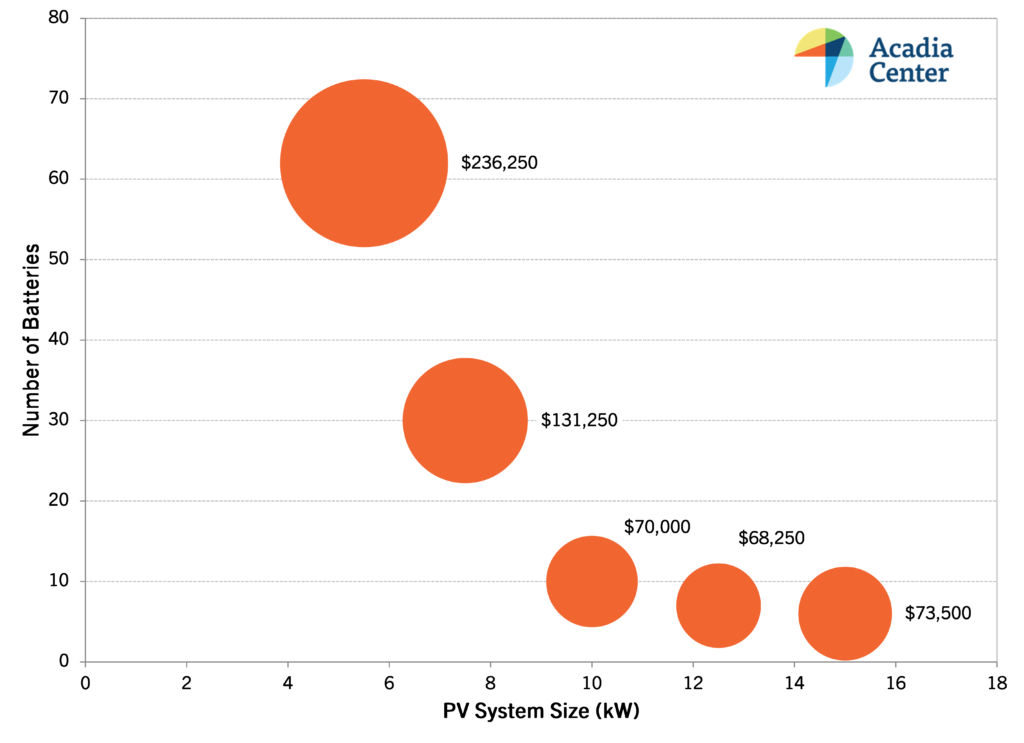
The Fine Print: Our assessment used a blend of Department of Energy’s hourly electric consumption models to represent a new, high-efficiency single family home in each location. The National Renewable Energy Laboratory’s PVWatts tool was used to simulate hourly electric generation in each of the homes for the various array sizes. At net zero, the PV array size was set so that generation was approximately equivalent to consumption on an annual basis. The battery storage was modeled so that there was sufficient storage and production to meet hourly demand for every hour of the year. No safety margin was included, nor were considerations made for degradation of storage capacity or whether instantaneous demands (such as an air conditioning unit’s start-up requirements) could be met. Costs of $3.50 per watt for PV and $3,500 for each 10 KWh of battery storage were used for determining optimum configurations. Additional storage system integration costs were not included.
Rallying Support to Lift Caps on Net Metering in Massachusetts
The Challenge
A previous post, Massachusetts Net Metering and Solar Policy Status and Next Steps , addressed the Net Metering and Solar Task Force report and outlined some considerations for reforms going forward. Front and center right now is the issue of statutory net metering caps,* which limit the amount of solar that can be credited for generating electricity.
These caps have been reached in National Grid’s service territory, which is preventing municipal, community-shared, and low-income solar projects from moving forward in 171 cities and towns across the Commonwealth. Policymakers in the Baker Administration and Legislature have made it clear that the caps, although arbitrary, cannot be lifted until there is a long-term framework in place that resolves any problems with the current system. At a hearing before the Joint Committee on Telecommunications, Utilities and Energy on June 2, Acadia Center and many other stakeholders encouraged legislators to move forward on this issue.
The Proposal
The majority position represented in the Net Metering and Solar Task Force report outlined a sensible, high-level approach but many more details are necessary for concrete implementation. Since the release of the Task Force report on April 30th, Acadia Center has engaged extensively with a range of colleagues to determine the best way to move forward. Prior to the June 2nd hearing, the product of those discussions was released —the “Next Generation Solar Policy Framework for Massachusetts .”
This framework, now endorsed by 52 organizations–spanning sustainable energy and environmental advocates, labor, solar developers, business groups and community groups–presents a detailed and sensible approach for reforms to the current system that will allow MA to lift the caps soon and eventually eliminate them. The key aspects of the proposal are:
- Lift caps on solar development;
- Preserve key aspects of Massachusetts’ net metering and virtual net metering programs;
- Phase in a new system of distribution credits and a new “energy system benefit credit” for solar generators based on analysis of the long-run net costs and benefits of solar generation to the electric grid. These changes should be phased in based on availability of appropriate and cost-effective metering and billing mechanisms, and the right of individuals to produce clean electricity for their own consumption must be respected. The credits for generation and transmission would remain the same as current policy.
- Establish a new “adjustable block” compensation mechanism that promotes more cost-effective solar development, provides more certainty for developers, and allows Massachusetts to pursue ambitious clean energy goals;
- Avoid increased fixed charges and minimum bills, which penalize low-income customers and undermine efficiency incentives; and,
- Appropriately grandfather existing projects under the policies under which they were built.
What are the Next Steps?
At the June 2nd hearing, there was a widespread show of support among stakeholders and legislators testifying for lifting the net metering caps. Many of the bills currently up for discussion would lift the net metering caps and promote solar, but do not contain many of the essential elements necessary for long-term reforms. Acadia Center and our allies are working to build support so that the Committee will soon take up and pass a comprehensive bill that encompasses the ideas presented in the Next Generation Solar Policy Framework for Massachusetts. Moving these measures forward is an important piece of the effort to advance a low-carbon, consumer-friendly energy future.
The framework is available here and those interested in more information or signing on can contact mlebel@acadiacenter.org.
* Net metering allows customers to generate their own electricity (through, for example, a rooftop solar PV system) in order to offset their electricity usage. Net metering can lower a customer’s electricity bill by reducing the amount of electricity that the customer buys from the distribution company (the utility). Net metering allows customers to receive credits for any electricity that they generate but do not use. Each distribution company in MA has a cap, and after it is hit, no more customers can use net metering. Small systems, primarily those under 10 kW of capacity, are exempt from the caps. For more info see: http://www.mass.gov/eea/grants-and-tech-assistance/guidance-technical-assistance/agencies-and-divisions/dpu/net-metering-faqs.html#6
New Analysis: $10 Fixed Electric Charge Cap to Lower Most CT Monthly Bills for Eversource Energy’s Residential Customers
At Connecticut’s General Assembly these days, a debate is raging about consumers’ control over their electric use and costs. On one side, the utilities defend ever higher “fixed charges” on electric bills; on the other, consumers and their advocacy allies push to lower and cap those charges at $10. A fixed charge is a monthly flat minimum charge on a customer’s electricity account that should be an accurate calculation of the minimum, short-term fixed cost of connecting a customer to the grid. High fixed charges hurt consumers by increasing the amount that must be paid regardless of energy use. These fixed charges interfere with benefits from energy efficiency measures and diminish consumer control over energy generation, consumption, and costs.
With the highest residential fixed charges in New England for any major electric utility, Connecticut’s Eversource Energy and United Illuminating continue to increase already high fixed charges and to oppose legislative attempts to lower or cap these charges. In response to inaccurate information distributed by Eversource lobbyists at the Capitol, Acadia Center completed an analysis which shows that significantly more than half of Eversource residential customer monthly bills would decrease if the General Assembly enacts a $10 fixed charge cap, as proposed in a pending Senate bill.
In a May 12th email, an Eversource lobbyist claimed that, “more than half of our customers would see an increase in their overall bill if the fixed charge is lowered,” and that, “a $10 fixed charge is actually more regressive than a $19.25 fixed charge.” However, using information provided by Eversource in its 2014 rate case before the Public Utility Regulatory Authority (PURA), Acadia Center found that:
- All residential customers using less electricity than the average in a given month would pay less if the fixed charge decreases from $19.25, the existing amount, to $10, the maximum allowed under the proposed cap;
- 61% of monthly bills in Eversource’s primary residential rate class fall below the actual average of 730 kilowatt hours per month; and,
- Increasing the residential fixed charge to $25.50 per month—the amount sought by Eversource in its rate case—would increase monthly bills for all customers that use less electricity than the average.
The analysis showed that an overwhelming majority of Eversource’s approximately 1 million residential customers would pay higher bills and would see a decreased incentive to use energy efficiently under the utility’s high fixed charge approach. This analysis rebutted claims by Eversource lobbyists that consumers do not stand to benefit from lower fixed monthly charges.
Acadia Center released its analysis of Eversource’s claims against the fixed charge cap on May 18th. The issue continues to be debated in Connecticut’s General Assembly with a vote hopefully soon to be scheduled in the Senate on Senate Bill 570.
Learn more about fixed charge caps from Acadia Center’s Senior Attorney and Connecticut Office Director Bill Dornbos by watching this panel discussion video: CT Mirror/AARP Google Hangout: Fixed-Rate Cap on Electric Rates
Principles to Strengthen the RGGI Program
The Regional Greenhouse Gas Initiative (RGGI)—a market-based program developed to reduce CO2 emissions from the power sector—has been a success through its first six years of operation. Since the program began in 2009, the nine participating states have seen electricity prices fall while harmful emissions from the power sector have been reduced. Revenue from emission allowance auctions has been reinvested in programs that help consumers make energy efficiency improvements in their homes and save on energy costs. RGGI’s success shows the ability of market-based approaches to deliver cost-effective emissions reductions, and demonstrates how states can work together to develop sound energy policies.
Ahead of the upcoming 2016 RGGI Program Review process, Acadia Center and 31 other environmental groups and clean energy businesses have produced a set of joint principles to strengthen the program and enable the RGGI states to comply with U.S. EPA’s Clean Power Plan which requires reductions in power plant carbon emissions nation-wide (30 percent below 2005 levels by 2030). The following reforms to RGGI are needed to meet these requirements and improve the program going forward.
1) Extend the RGGI Cap
The RGGI cap currently extends to 2020, while EPA’s Clean Power Plan requires that states demonstrate how they will meet emissions targets in 2030. By extending the RGGI cap to 2030, the RGGI states will be consistent with EPA’s targets and will provide market certainty to encourage clean energy investments.
2) Correct the Emissions Cap Decline Trajectory
The way the RGGI cap declines must be corrected to ensure achievement of deeper long-term emissions reductions. The current cap declines by 2.5% annually based on a percentage of the prior year’s cap. Instead, the cap should decline by 2.5% of the 2014 base year, and continue to decrease by that same fixed quantity of allowances each year. By 2050, the percentage-based reduction would allow four times more emissions than the fixed quantity approach and could prevent states from meeting their 2050 GHG reduction targets.
3) Revise or Remove the Cost Containment Reserve
In order to reduce price volatility, the RGGI states established a Cost Containment Reserve (CCR) that creates additional allowances when price thresholds are reached. The release of additional allowances could push RGGI emissions above EPA’s proposed 2030 emissions targets and prevent the RGGI states from achieving compliance with the Clean Power Plan. The CCR should be modified to ensure achievement of emissions reductions by drawing allowances from under the cap, rather than minting new allowances.
 With the changes above, the RGGI states will demonstrate a commitment to driving emissions reductions while creating a model of compliance with the federal Clean Power Plan for other states to emulate.
With the changes above, the RGGI states will demonstrate a commitment to driving emissions reductions while creating a model of compliance with the federal Clean Power Plan for other states to emulate.





















